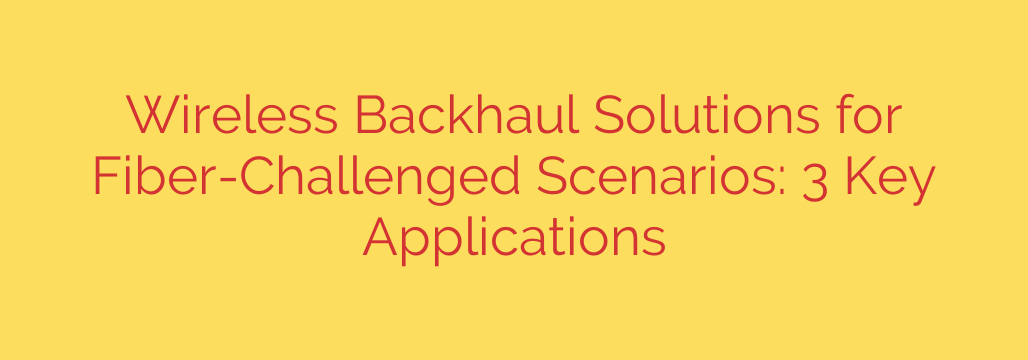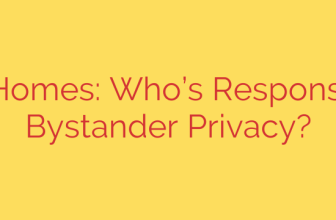
When Fiber Isn’t an Option: 3 Powerful Uses for Wireless Backhaul
In our hyper-connected world, high-speed internet is no longer a luxury—it’s essential infrastructure. Fiber optic cable is often seen as the gold standard for delivering blazing-fast, reliable connectivity. But what happens when laying fiber is impractical, prohibitively expensive, or simply impossible? From rugged terrain to dense urban jungles, physical barriers often stand in the way of digital progress.
This is where wireless backhaul technology emerges as a powerful and flexible solution. It provides the crucial link—the “backhaul”—that connects smaller, local networks back to the main internet backbone using wireless signals instead of physical cables. Far from being a mere backup, modern wireless backhaul offers fiber-like speeds and reliability, unlocking new possibilities for connectivity.
Here are three key applications where wireless backhaul is not just an alternative, but the ideal solution.
1. Expanding Broadband to Rural and Remote Areas
The “digital divide” remains a significant challenge, with many rural and underserved communities left struggling with slow, unreliable internet. The primary obstacle is often the immense cost of trenching fiber optic cables over miles of difficult terrain to serve a small number of subscribers. For telecom providers, the return on investment simply isn’t there.
Wireless backhaul completely changes this economic equation. By setting up point-to-point (PTP) or point-to-multipoint (PMP) microwave links, internet service providers can bridge vast distances in a fraction of the time and cost. A single wireless link can connect a remote town’s distribution point to the core fiber network dozens of miles away. From there, connectivity can be delivered to individual homes and businesses via smaller wireless links or existing infrastructure.
Key takeaway: Wireless backhaul provides a cost-effective and rapid way to deliver fiber-like speeds to communities that would otherwise be left behind, directly addressing the last-mile connectivity problem.
2. Powering Agile Urban Networks and Temporary Events
It may seem counterintuitive, but some of the most fiber-challenged environments are our busiest cities. The process of digging up streets, navigating existing utilities, and securing permits can be a logistical and financial nightmare. This makes it difficult to connect new buildings, upgrade business parks, or deploy temporary networks for large-scale events.
Wireless backhaul, especially using high-frequency millimeter-wave (mmWave) technology, offers a surgical solution. These systems can be installed on rooftops or poles to create gigabit-speed links between buildings, bypassing congested streets entirely. This is perfect for:
- Connecting enterprise campuses without costly private fiber runs.
- Providing high-capacity internet for temporary events like music festivals, sporting events, or outdoor conferences.
- Establishing immediate connectivity for disaster recovery sites or construction projects.
Key takeaway: In dense urban areas, wireless backhaul offers the agility to bypass construction delays and provide gigabit-speed connectivity in days, not months.
3. Building Resilient Public Safety and Smart City Networks
Modern cities rely on a complex web of connected devices for public safety and operational efficiency. This includes everything from high-definition CCTV cameras and traffic management sensors to public Wi-Fi access points and emergency communication systems. Each of these endpoints requires a reliable, secure, and high-capacity connection back to a central hub.
Relying solely on fiber for this critical infrastructure creates a single point of failure. A single, accidental fiber cut during construction could knock out emergency services or traffic monitoring for an entire district.
Wireless backhaul provides an ideal layer of redundancy and resilience. By creating a parallel wireless network, cities can ensure that critical systems remain online even if the physical fiber infrastructure is compromised. Furthermore, it allows for the flexible and cost-effective placement of cameras and sensors exactly where they are needed, not just where fiber is already available.
Key takeaway: Wireless backhaul enhances network resiliency, providing a secure and reliable backbone for critical public safety and smart city applications.
Security and Best Practices for Wireless Backhaul
While incredibly effective, deploying a wireless backhaul network requires careful planning to ensure performance and security. If your organization is considering this technology, keep these tips in mind:
- Conduct a Thorough Path Analysis: Most high-performance wireless backhaul systems require a clear line of sight (LoS) between antennas. Use specialized software to analyze the terrain and identify any potential obstructions like buildings or trees before installation.
- Prioritize Robust Encryption: Wireless signals can be intercepted. Always use strong, standards-based encryption, such as AES-256, to protect all data transmitted over the link. This ensures your data remains confidential and secure from eavesdropping.
- Choose the Right Frequency Spectrum: Your choice of frequency (licensed or unlicensed) will impact performance and cost. Licensed spectrum offers protection from interference but comes at a higher cost, making it ideal for critical infrastructure. Unlicensed spectrum is more affordable but requires careful planning to mitigate potential interference from other nearby networks.
Ultimately, wireless backhaul technology is a critical enabler of modern digital infrastructure. It is a mature, reliable, and cost-effective solution that elegantly solves complex connectivity challenges, proving that the absence of fiber no longer means the absence of high-speed opportunity.
Source: https://feedpress.me/link/23532/17171307/no-fiber-no-problem-3-use-cases-wireless-backhaul-solves-easily








